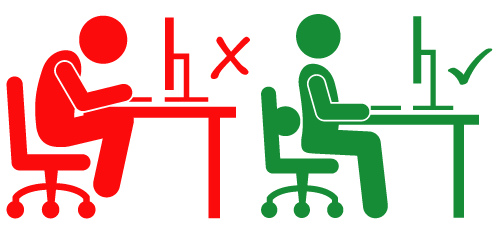Back pain can be caused by living at your desk, standing all day at your register, or walking the sales floor. But did you know your back may not be the root of the pain?
When we stay in a single position, or move infrequently, we push the muscles that hold us in those positions. Without stretching and good body mechanics or ergonomics, we stop using the muscles responsible and start using others to compensate.
Take a look at the person sitting. Note the hunched back, forward head posture, and crunched arms. With the exaggerated “C” look of the spine it can be easy to assume the back is where the problem lies. This person most likely complains of low back and shoulder pain, and when they receive treatment to these areas they find some temporary pain relief.
But look at the image again. Note how the abdomen in crunched, the pecs drawn together, the raise of the leg and foot. Now we see both sides of the problem. The muscles on the back, shoulder blades, and gluts have become overstretched and weak because to the pecs, abdominals, and quads became adaptively shorter as they settled into bad posture.
Now that we see the full picture, treatment becomes more effective. Using a 3:1 rule, an LMT can assess the tissue and focus a majority of their time on the adaptively short muscles by stretching them out, increasing circulation, and working the tenuous attachments. Less time would be spent on the overstretched muscles, with the goals of increased circulation and attachment work. Each body is different and the specific muscles worked would vary.
If you deal with chronic back pain, you now know two great methods of treatment. First, take a look at your posture throughout the day and make minor corrections. Then, talk to your massage therapist about what you noticed, where you feel pain, and when to book your next appointment.

